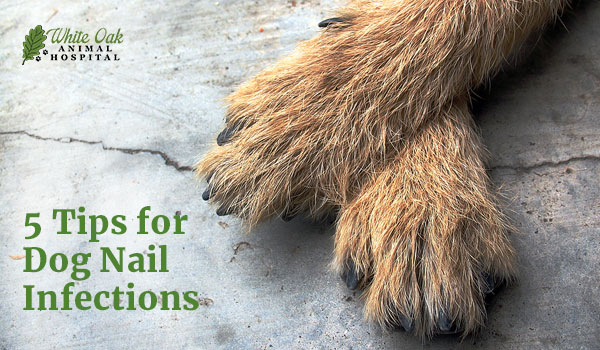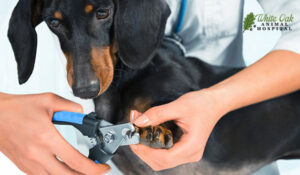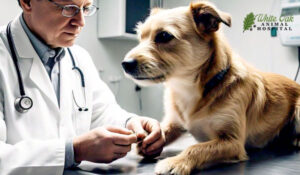
Dog nail infections are a common yet often overlooked health issue that can cause significant pain and discomfort for your pet. These infections occur when bacteria, fungi, or other pathogens invade the nail bed or surrounding tissue, leading to inflammation, swelling, and pain. Addressing dog nail infections promptly is crucial to prevent the infection from spreading and causing more severe complications. Early intervention not only alleviates your dog’s discomfort but also helps avoid potential long-term damage to their nails and overall paw health.
Understanding Dog Nail Infections
 Dog nail infections can arise from various causes, making it essential to understand the common risk factors and signs. Trauma to the nail, such as cracks, splits, or improper trimming, can create an entry point for bacteria and fungi, leading to infection. Other contributing factors include underlying health conditions, such as autoimmune diseases or allergies, which can compromise your dog’s immune system and make them more susceptible to infections. Environmental factors, like prolonged exposure to wet or dirty conditions, can also increase the likelihood of developing dog nail infections.
Dog nail infections can arise from various causes, making it essential to understand the common risk factors and signs. Trauma to the nail, such as cracks, splits, or improper trimming, can create an entry point for bacteria and fungi, leading to infection. Other contributing factors include underlying health conditions, such as autoimmune diseases or allergies, which can compromise your dog’s immune system and make them more susceptible to infections. Environmental factors, like prolonged exposure to wet or dirty conditions, can also increase the likelihood of developing dog nail infections.
Recognizing the signs of dog nail infections early is vital for timely treatment. Common symptoms include redness, swelling, and discharge around the nail, as well as limping or favoring one paw. In more severe cases, you might notice that your dog is excessively licking or chewing at the affected area, indicating pain or discomfort. If left untreated, dog nail infections can lead to more serious health issues, such as abscesses or the spread of infection to other parts of the body.
Diagnosis and Veterinary Intervention
 A professional diagnosis is essential for effectively treating dog nail infections. Your veterinarian will conduct a thorough examination of your dog’s nails and surrounding tissue to determine the extent of the infection. Diagnostic procedures may include taking a sample of the discharge or tissue for laboratory testing to identify the specific pathogen responsible for the infection. In some cases, X-rays or other imaging techniques may be necessary to assess the depth of the infection and whether it has spread to the bone or other structures.
A professional diagnosis is essential for effectively treating dog nail infections. Your veterinarian will conduct a thorough examination of your dog’s nails and surrounding tissue to determine the extent of the infection. Diagnostic procedures may include taking a sample of the discharge or tissue for laboratory testing to identify the specific pathogen responsible for the infection. In some cases, X-rays or other imaging techniques may be necessary to assess the depth of the infection and whether it has spread to the bone or other structures.
Veterinary intervention is crucial in ensuring that dog nail infections are treated properly. Depending on the severity of the infection, your veterinarian may recommend a combination of treatments, including antibiotics, topical medications, and pain management strategies. Following your veterinarian’s guidance closely will help ensure a successful recovery and reduce the risk of complications.
Top 5 Ways to Treat Dog Nail Infections
1. Proper Hygiene and Grooming
Maintaining proper hygiene and grooming practices is one of the most effective ways to treat and prevent dog nail infections. Regular nail trimming helps prevent cracks and splits that can serve as entry points for bacteria and fungi. It’s important to use pet-safe grooming tools to avoid causing trauma to the nails during trimming. Additionally, keeping your dog’s paws clean and dry, especially after walks in wet or muddy conditions, can reduce the risk of dog nail infections.
2. Antibiotic Treatment
Antibiotics play a critical role in managing dog nail infections caused by bacterial pathogens. Depending on the severity of the infection, your veterinarian may prescribe oral or topical antibiotics to eliminate the bacteria and promote healing. It’s essential to follow the prescribed dosage and duration of treatment to ensure that the infection is fully eradicated. Misuse or incomplete use of antibiotics can lead to antibiotic resistance and recurrence of the infection.
3. Topical Treatments
Topical Treatments
Topical treatments, such as medicated ointments or antifungal solutions, are often recommended for treating dog nail infections. These treatments are applied directly to the affected area, allowing the medication to penetrate the nail bed and surrounding tissue. Topical treatments can be particularly effective for fungal infections or superficial bacterial infections. However, it’s important to follow your veterinarian’s instructions carefully, as improper application can delay healing or exacerbate the infection.
4. Pain Management
Managing your dog’s pain during treatment is crucial for their comfort and well-being. Pain-relief medications, such as non-steroidal anti-inflammatory drugs (NSAIDs), can help alleviate discomfort associated with dog nail infections. In addition to medication, you can use techniques like cold compresses to reduce swelling and soothe the affected area. Ensuring that your dog is comfortable and pain-free will help them recover more quickly and reduce stress during the healing process.
5. Preventive Measures
 Preventing dog nail infections involves implementing strategies to minimize the risk of future infections. Regular grooming and hygiene practices are essential, as is maintaining a clean living environment for your dog. If your dog has a history of nail infections, consider making lifestyle adjustments, such as providing protective footwear during walks in harsh conditions or avoiding activities that could cause trauma to the nails. Regular veterinary check-ups are also important for monitoring your dog’s nail health and catching any potential issues early.
Preventing dog nail infections involves implementing strategies to minimize the risk of future infections. Regular grooming and hygiene practices are essential, as is maintaining a clean living environment for your dog. If your dog has a history of nail infections, consider making lifestyle adjustments, such as providing protective footwear during walks in harsh conditions or avoiding activities that could cause trauma to the nails. Regular veterinary check-ups are also important for monitoring your dog’s nail health and catching any potential issues early.
Home Care and Follow-Up
Providing proper home care between veterinary visits is vital for ensuring that your dog’s nail infection heals completely. Follow your veterinarian’s instructions for administering medications, cleaning the affected area, and monitoring your dog’s progress. It’s important to keep the area clean and dry and to prevent your dog from licking or chewing at the infected nail, as this can introduce more bacteria and delay healing.
Regular follow-up appointments with your veterinarian are crucial for monitoring the effectiveness of the treatment and making any necessary adjustments. These visits allow your vet to assess the healing process and ensure that the infection is fully resolved. Ongoing vigilance and adherence to your vet’s recommendations will help prevent future dog nail infections and ensure your pet’s paws remain healthy.
 Addressing dog nail infections promptly and effectively is essential for stopping the pain and preventing further complications. By understanding the common causes, recognizing the signs, and following your veterinarian’s treatment plan, you can help your dog recover quickly and comfortably. At White Oak Animal Hospital, we offer integrative options, including TCVM Telemedicine consultations, to provide comprehensive care for your pet. With over 28 years of experience, our team is dedicated to ensuring your dog’s health and well-being. We encourage you to schedule a consultation with us to discuss how we can help manage and prevent dog nail infections, ensuring your pet stays happy and healthy.
Addressing dog nail infections promptly and effectively is essential for stopping the pain and preventing further complications. By understanding the common causes, recognizing the signs, and following your veterinarian’s treatment plan, you can help your dog recover quickly and comfortably. At White Oak Animal Hospital, we offer integrative options, including TCVM Telemedicine consultations, to provide comprehensive care for your pet. With over 28 years of experience, our team is dedicated to ensuring your dog’s health and well-being. We encourage you to schedule a consultation with us to discuss how we can help manage and prevent dog nail infections, ensuring your pet stays happy and healthy.
Frequently Asked Questions
How can I prevent dog nail infections?
Preventing dog nail infections involves regular grooming and hygiene practices, such as trimming your dog’s nails regularly and keeping their paws clean and dry. Avoiding activities that could cause trauma to the nails and providing protective footwear during walks in harsh conditions can also help prevent infections.
Can dog nail infections heal on their own?
While some mild dog nail infections may resolve on their own, it’s important to seek veterinary advice for proper diagnosis and treatment. Untreated infections can worsen and lead to more severe health issues, so prompt intervention is recommended.
How do I know if my dog has a nail infection?
Common signs of dog nail infections include redness, swelling, discharge, and limping. Your dog may also lick or chew at the affected area. If you notice any of these symptoms, it’s important to consult your veterinarian for a professional diagnosis.
Are certain breeds more prone to dog nail infections?
Some breeds with long, thick nails or those prone to allergies may be more susceptible to dog nail infections. Regular grooming and monitoring are especially important for these breeds to prevent infections.
What should I do if my dog’s nail infection doesn’t improve with treatment?
If your dog’s nail infection doesn’t improve with treatment, contact your veterinarian for further evaluation. Additional diagnostic tests or alternative treatments may be necessary to resolve the infection and prevent complications.
Related Posts
-
5 Signs of Dog Nail Bed Infections: Spot the Symptoms Early
Dog nail bed infections are a common concern for dog owners and require prompt…
-
Learn How To Alleviate Dog Leg Pain Naturally
Dog arthritis is the top cause of chronic dog leg pain. Arthritis affects approximately 20%…
-
How To Identify And Treat Dog Cancer
Dog cancer is an unfortunately common malady. Common causes of dog cancer include environmental pollution,…
-
Effective Home Remedies for Dog Ear Infections: Addressing 5 Common Causes
Home remedies for dog ear infections can offer a practical and cost-effective solution to ear…









